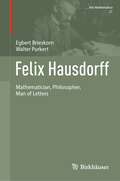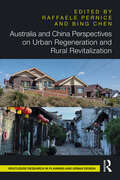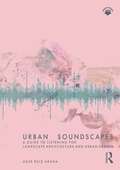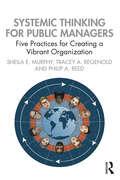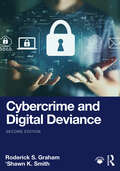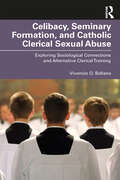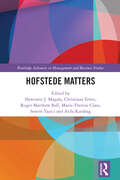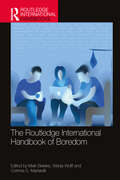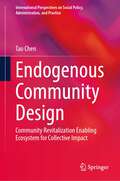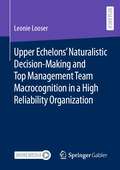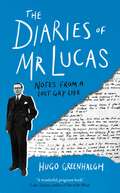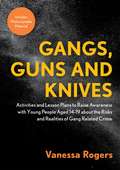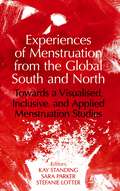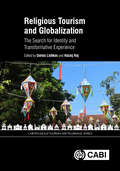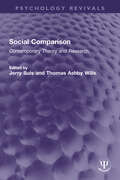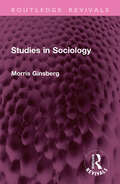- Table View
- List View
Felix Hausdorff: Mathematician, Philosopher, Man of Letters (Vita Mathematica #21)
by Egbert Brieskorn Walter PurkertFelix Hausdorff is a singular phenomenon in the history of science. As a mathematician, he played a major role in shaping the development of modern mathematics in the 20th century. He founded general topology as an independent mathematical discipline, while enriching set theory with a number of fundamental concepts and results. His general approach to measure and dimension led to profound developments in numerous mathematical disciplines, and today Hausdorff dimension plays a central role in fractal theory with its many fascinating applications by means of computer graphics. Hausdorff ’s remarkable mathematical versatility is reflected in his published work: today, no fewer than thirteen concepts, theorems and procedures carry his name. Yet he was not only a creative mathematician – Hausdorff was also an original philosophical thinker, a poet, essayist and man of letters. Under the pseudonym Paul Mongré, he published a volume of aphorisms, an epistemological study, abook of poetry, an oft-performed play, and a number of notable essays in leading literary journals. As a Jew, Felix Hausdorff was increasingly persecuted and humiliated under the National Socialist dictatorship. When deportation to a concentration camp was imminent, he, along with his wife and sister-in law, decided to take their own lives. This book will be of interest to historians and mathematicians already fascinated by the rich life of Felix Hausdorff, as well as to those readers who wish to immerse themselves in the intricate web of intellectual and political transformations during this pivotal period in European history.
Australia and China Perspectives on Urban Regeneration and Rural Revitalization (Routledge Research in Planning and Urban Design)
by Raffaele Pernice Bing ChenThis edited volume reviews important contemporary issues through relevant case studies and research in China and Australia, such as the challenges posed by climate change, the development of eco-urban design, research on sustainable habitats and the relationship between ecology, green architecture and city regeneration, as well as, in general, the future of the city in the new millennium.The authors represent a broad selection of international experts, young scholars and established academics who discuss themes related to urban–rural destruction and economic and spatial regeneration techniques, the sustainable reconversion of natural landscapes and eco-urban design in the context of the current evolution of architectural and urbanism practice. The book aims to explain the conditions in which the contemporary debate about urban regeneration and rural revitalisation has developed in Australia and China, presented by different theoretical and methodological perspectives. It also provides a multifaceted and critical analysis of relevant case studies and urban experiences in Australia and China, focusing on environmental disruption, resized urban interventions and the need for more efficient and sustainable forms of regeneration and urban renewal practice in urban–rural contexts.This book will be an invaluable resource for architects, planners, architectural and urban historians, geographers, and scholars interested in modern Australian and Chinese architecture and urbanism.
Australia and China Perspectives on Urban Regeneration and Rural Revitalization (Routledge Research in Planning and Urban Design)
This edited volume reviews important contemporary issues through relevant case studies and research in China and Australia, such as the challenges posed by climate change, the development of eco-urban design, research on sustainable habitats and the relationship between ecology, green architecture and city regeneration, as well as, in general, the future of the city in the new millennium.The authors represent a broad selection of international experts, young scholars and established academics who discuss themes related to urban–rural destruction and economic and spatial regeneration techniques, the sustainable reconversion of natural landscapes and eco-urban design in the context of the current evolution of architectural and urbanism practice. The book aims to explain the conditions in which the contemporary debate about urban regeneration and rural revitalisation has developed in Australia and China, presented by different theoretical and methodological perspectives. It also provides a multifaceted and critical analysis of relevant case studies and urban experiences in Australia and China, focusing on environmental disruption, resized urban interventions and the need for more efficient and sustainable forms of regeneration and urban renewal practice in urban–rural contexts.This book will be an invaluable resource for architects, planners, architectural and urban historians, geographers, and scholars interested in modern Australian and Chinese architecture and urbanism.
Urban Soundscapes: A Guide to Listening for Landscape Architecture and Urban Design
by Usue Ruiz AranaSound and listening are intrinsically linked to how we experience and engage with places and communities. This guide puts forward a new conceptual framework of embodied affectivity that emphasises listening in urban research and design and advances new ways of knowing and making. The guide invites landscape architects and urban designers to become soundscape architects and offers practical advice on sound and listening applicable to each stage of a design project: from reading the environment to intervening on it.Urban Soundscapes foregrounds listening as an affective mediator between subjects and multispecies environments, and a vehicle to think and conceptualise environmental research and design beyond prevailing visual and human-centred modes. The guide expands landscape architects’ and urban designers’ tools and skills to assess existing soundscapes, predict how those soundscapes will be altered through their designs, consider sound as a creative and active part of the design process and envisage how users might perceive and be affected by those soundscapes as they evolve in time. The volume sits in the interface of research and practice and interweaves theoretical, methodological and creative contributions from acoustic ecology, ecoacoustics, bioacoustics and sound art. Each of the design stages is illustrated through project examples that demonstrate the many advantages of incorporating attentive listening and sound into Landscape Architecture and Urban Design Practice. This book shows how incorporating listening and sounding as part of the design process promotes slow and subtle ways of practice, adds social and ecological value through the reduction of noise pollution and by monitoring the health of habitats, and enables the design of soundscapes that complement the character and design intent of a scheme and elicit joy and wonder.The book will be of interest to practitioners and academics in landscape architecture, and other design and spatial fields such as urban design, architecture, geography and engineering, who play a primary role in the composition of the soundscape.
Urban Soundscapes: A Guide to Listening for Landscape Architecture and Urban Design
by Usue Ruiz AranaSound and listening are intrinsically linked to how we experience and engage with places and communities. This guide puts forward a new conceptual framework of embodied affectivity that emphasises listening in urban research and design and advances new ways of knowing and making. The guide invites landscape architects and urban designers to become soundscape architects and offers practical advice on sound and listening applicable to each stage of a design project: from reading the environment to intervening on it.Urban Soundscapes foregrounds listening as an affective mediator between subjects and multispecies environments, and a vehicle to think and conceptualise environmental research and design beyond prevailing visual and human-centred modes. The guide expands landscape architects’ and urban designers’ tools and skills to assess existing soundscapes, predict how those soundscapes will be altered through their designs, consider sound as a creative and active part of the design process and envisage how users might perceive and be affected by those soundscapes as they evolve in time. The volume sits in the interface of research and practice and interweaves theoretical, methodological and creative contributions from acoustic ecology, ecoacoustics, bioacoustics and sound art. Each of the design stages is illustrated through project examples that demonstrate the many advantages of incorporating attentive listening and sound into Landscape Architecture and Urban Design Practice. This book shows how incorporating listening and sounding as part of the design process promotes slow and subtle ways of practice, adds social and ecological value through the reduction of noise pollution and by monitoring the health of habitats, and enables the design of soundscapes that complement the character and design intent of a scheme and elicit joy and wonder.The book will be of interest to practitioners and academics in landscape architecture, and other design and spatial fields such as urban design, architecture, geography and engineering, who play a primary role in the composition of the soundscape.
Systemic Thinking for Public Managers: Five Practices for Creating a Vibrant Organization
by Sheila Murphy Tracey Regenold Philip ReedOffering a pathway to vibrant organizations, this book integrates systems thinking, critical thinking, and design thinking, and provides the tools needed to proactively apply them in the social systems where we live and work. Systemic thinking—the combination of systems thinking, critical systems thinking, and design thinking—provides a way of addressing the complexity of problems faced by public sector managers. Far too often systemic thinking has been discussed theoretically rather than practically. This book changes that, enabling public sector managers and leaders to connect staff, partners, and stakeholders in the pursuit of thoughtfully designed and responsive service. Clearly written and designed to be put to immediate use on the job, each chapter provides a discussion of one specific practice. Included are guiding principles, a case study, relevant practical tools, and suggestions of for additional practice and reading.Using this book, managers of social systems such as public welfare, healthcare, public schools and libraries, housing and community development, and students of public administration will gain a deeper understanding of organizational systems and design, and a new toolkit to fortify their own organizations.
Systemic Thinking for Public Managers: Five Practices for Creating a Vibrant Organization
by Sheila Murphy Tracey Regenold Philip ReedOffering a pathway to vibrant organizations, this book integrates systems thinking, critical thinking, and design thinking, and provides the tools needed to proactively apply them in the social systems where we live and work. Systemic thinking—the combination of systems thinking, critical systems thinking, and design thinking—provides a way of addressing the complexity of problems faced by public sector managers. Far too often systemic thinking has been discussed theoretically rather than practically. This book changes that, enabling public sector managers and leaders to connect staff, partners, and stakeholders in the pursuit of thoughtfully designed and responsive service. Clearly written and designed to be put to immediate use on the job, each chapter provides a discussion of one specific practice. Included are guiding principles, a case study, relevant practical tools, and suggestions of for additional practice and reading.Using this book, managers of social systems such as public welfare, healthcare, public schools and libraries, housing and community development, and students of public administration will gain a deeper understanding of organizational systems and design, and a new toolkit to fortify their own organizations.
Cybercrime and Digital Deviance
by Roderick S. Graham 'Shawn K. SmithCybercrime and Digital Deviance, Second Edition, combines insights from sociology, criminology, psychology, and cybersecurity to explore cybercrimes such as hacking, identity theft, and romance scams, along with forms of digital deviance such as pornography addiction, trolling, and “canceling” people for perceived violations of norms.Other issues are explored including cybercrime investigations, nation-state cybercrime, the use of algorithms in policing, cybervictimization, and expanded discussion of the theories used to explain cybercrime. Graham and Smith conceptualize the online space as a distinct environment for social interaction, framing their work with assumptions informed by their respective work in urban sociology and spatial criminology, and offering an engaging entry point for understanding what may appear to be a technologically complex course of study. The authors apply a modified version of a typology developed by David Wall: cybertrespass, cyberfraud, cyberviolence, and cyberpornography. This typology is simple enough for students just beginning their inquiry into cybercrime, while its use of legal categories of trespassing, fraud, violent crimes against persons, and moral transgressions provides a solid foundation for deeper study. In this edition each chapter includes a new “Current Events and Critical Thinking” section, using concepts from the chapter to explore a specific event or topic like the effect of disinformation on social cohesion and politics.Taken together, Graham and Smith’s application of a digital environment and Wall’s cybercrime typology makes this an ideal upper-level text for students in sociology and criminal justice. It is also an ideal introductory text for students within the emerging disciplines of cybercrime and cybersecurity.
Cybercrime and Digital Deviance
by Roderick S. Graham 'Shawn K. SmithCybercrime and Digital Deviance, Second Edition, combines insights from sociology, criminology, psychology, and cybersecurity to explore cybercrimes such as hacking, identity theft, and romance scams, along with forms of digital deviance such as pornography addiction, trolling, and “canceling” people for perceived violations of norms.Other issues are explored including cybercrime investigations, nation-state cybercrime, the use of algorithms in policing, cybervictimization, and expanded discussion of the theories used to explain cybercrime. Graham and Smith conceptualize the online space as a distinct environment for social interaction, framing their work with assumptions informed by their respective work in urban sociology and spatial criminology, and offering an engaging entry point for understanding what may appear to be a technologically complex course of study. The authors apply a modified version of a typology developed by David Wall: cybertrespass, cyberfraud, cyberviolence, and cyberpornography. This typology is simple enough for students just beginning their inquiry into cybercrime, while its use of legal categories of trespassing, fraud, violent crimes against persons, and moral transgressions provides a solid foundation for deeper study. In this edition each chapter includes a new “Current Events and Critical Thinking” section, using concepts from the chapter to explore a specific event or topic like the effect of disinformation on social cohesion and politics.Taken together, Graham and Smith’s application of a digital environment and Wall’s cybercrime typology makes this an ideal upper-level text for students in sociology and criminal justice. It is also an ideal introductory text for students within the emerging disciplines of cybercrime and cybersecurity.
Celibacy, Seminary Formation, and Catholic Clerical Sexual Abuse: Exploring Sociological Connections and Alternative Clerical Training (Routledge Studies in the Sociology of Religion)
by Vivencio O. BallanoDoes the current celibate, semi-monastic, and all-male seminary formation contribute to the persistence of clerical sexual abuse in the Roman Catholic Church?Applying sociological theories on socialization, total institutions, and social resistance as the primary conceptual framework, and drawing on secondary literature, media reports, the author’s experience, interviews, and Church documents, this book argues that the Catholic Church’s institution of the celibate seminary formation as the only mode of clerical training for Catholic priests has resulted in negative unintended consequences to human formation such as the suspension of normal human socialization in society, psychosexual immaturity, and weak social control against clerical sexual abuse. The author thus contends that celibate training, while suitable for those who do live in religious or monastic communities, is inappropriate for those who are obliged to live alone and work in parishes. As such, an alternative model for diocesan clerical formation is advanced.A fresh look at the aptness – and effects – of celibate formation for diocesan clergy, this volume is the first to relate the persistence of Catholic clerical sexual abuse to celibate seminary formation, exploring the structural links between the two using sociological arguments and proposing an apprenticeship-based model of formation, which has numerous advantages as a form of clerical training. It will therefore appeal to scholars and students of religion, sociology, and theology, as well as those involved with seminary formation.
Celibacy, Seminary Formation, and Catholic Clerical Sexual Abuse: Exploring Sociological Connections and Alternative Clerical Training (Routledge Studies in the Sociology of Religion)
by Vivencio O. BallanoDoes the current celibate, semi-monastic, and all-male seminary formation contribute to the persistence of clerical sexual abuse in the Roman Catholic Church?Applying sociological theories on socialization, total institutions, and social resistance as the primary conceptual framework, and drawing on secondary literature, media reports, the author’s experience, interviews, and Church documents, this book argues that the Catholic Church’s institution of the celibate seminary formation as the only mode of clerical training for Catholic priests has resulted in negative unintended consequences to human formation such as the suspension of normal human socialization in society, psychosexual immaturity, and weak social control against clerical sexual abuse. The author thus contends that celibate training, while suitable for those who do live in religious or monastic communities, is inappropriate for those who are obliged to live alone and work in parishes. As such, an alternative model for diocesan clerical formation is advanced.A fresh look at the aptness – and effects – of celibate formation for diocesan clergy, this volume is the first to relate the persistence of Catholic clerical sexual abuse to celibate seminary formation, exploring the structural links between the two using sociological arguments and proposing an apprenticeship-based model of formation, which has numerous advantages as a form of clerical training. It will therefore appeal to scholars and students of religion, sociology, and theology, as well as those involved with seminary formation.
Hofstede Matters (ISSN)
by Sławomir J. Magala Christiane Erten Roger Matthew Bell Marie-Therese Claes Senem Yazici Atila KarabagHofstede Matters offers an updated presentation of the evolving views of academics and teachers who have worked with Hofstede’s research findings since the publication of the first edition of Culture’s Consequences in 1980. The authors reflect on their changing beliefs about the concept of cultural dimensions that led to a radical change in the way cultures were dealt with in business schools across Europe and beyond. Hofstede’s dimensions made "thinking" about culture more accessible overnight by creating a conceptual framework that teachers, students, managers, and consultants could grasp and easily apply in international comparisons. The book shows the man behind the value dimensions framework through the eyes of teachers and academics many of whom dealt with Hofstede personally. Contemporary contributors as well as younger academic fellow researchers evaluate the past paradigms and look behind the scenes to better understand the developments of the more recent ones. Jointly, they try to decide if Hofstede still helps us to overcome uncertainty when confronted with actions undertaken with different values in mind. Did he nudge us in the desirable direction? Offering a unique analysis of the strengths, criticisms, and legacy of Hofstede’s work, this book will appeal to academics and students across disciplines including cross-cultural management, critical management studies, and international management.
Hofstede Matters (ISSN)
Hofstede Matters offers an updated presentation of the evolving views of academics and teachers who have worked with Hofstede’s research findings since the publication of the first edition of Culture’s Consequences in 1980. The authors reflect on their changing beliefs about the concept of cultural dimensions that led to a radical change in the way cultures were dealt with in business schools across Europe and beyond. Hofstede’s dimensions made "thinking" about culture more accessible overnight by creating a conceptual framework that teachers, students, managers, and consultants could grasp and easily apply in international comparisons. The book shows the man behind the value dimensions framework through the eyes of teachers and academics many of whom dealt with Hofstede personally. Contemporary contributors as well as younger academic fellow researchers evaluate the past paradigms and look behind the scenes to better understand the developments of the more recent ones. Jointly, they try to decide if Hofstede still helps us to overcome uncertainty when confronted with actions undertaken with different values in mind. Did he nudge us in the desirable direction? Offering a unique analysis of the strengths, criticisms, and legacy of Hofstede’s work, this book will appeal to academics and students across disciplines including cross-cultural management, critical management studies, and international management.
The Routledge International Handbook of Boredom (Routledge International Handbooks)
This comprehensive text is a unique handbook dedicated to research on boredom. The book brings together leading contributors from across three continents and numerous fields to provide an interdisciplinary exploration of boredom, its theoretical underpinnings, its experiential properties, and the applied contexts in which it occurs.Boredom is often viewed as a mental state with little utility, though recent research suggests that it can be a powerful motivator of human behavior that shapes our actions in many ways. The book examines boredom from a range of perspectives and is comprised of three parts. Part I delves into the theoretical approaches to boredom, presenting methods for its measurement, explaining when and why boredom occurs, and scrutinizing the impact it has on our behavior. Part II focuses on the psychological and neural properties of boredom and its associations with a multitude of mental and interpersonal processes, such as self-control, mind-wandering, flow, and aggression. Part III presents boredom in practical contexts like school and work, and sheds light on its role for health-related behaviors, psychosocial well-being, and aesthetic experiences. The book concludes by summarizing the state of boredom research, identifying promising areas for future research, and providing directions for how research on boredom can be advanced. As the authoritative book on boredom, this handbook is an essential resource for students and researchers of psychology, sociology, education, sport science, and computer science.
The Routledge International Handbook of Boredom (Routledge International Handbooks)
by Maik Bieleke Wanja Wolff Corinna S. MartarelliThis comprehensive text is a unique handbook dedicated to research on boredom. The book brings together leading contributors from across three continents and numerous fields to provide an interdisciplinary exploration of boredom, its theoretical underpinnings, its experiential properties, and the applied contexts in which it occurs.Boredom is often viewed as a mental state with little utility, though recent research suggests that it can be a powerful motivator of human behavior that shapes our actions in many ways. The book examines boredom from a range of perspectives and is comprised of three parts. Part I delves into the theoretical approaches to boredom, presenting methods for its measurement, explaining when and why boredom occurs, and scrutinizing the impact it has on our behavior. Part II focuses on the psychological and neural properties of boredom and its associations with a multitude of mental and interpersonal processes, such as self-control, mind-wandering, flow, and aggression. Part III presents boredom in practical contexts like school and work, and sheds light on its role for health-related behaviors, psychosocial well-being, and aesthetic experiences. The book concludes by summarizing the state of boredom research, identifying promising areas for future research, and providing directions for how research on boredom can be advanced. As the authoritative book on boredom, this handbook is an essential resource for students and researchers of psychology, sociology, education, sport science, and computer science.
Endogenous Community Design: Community Revitalization Enabling Ecosystem for Collective Impact (International Perspectives on Social Policy, Administration, and Practice)
by Tao ChenThis book is a comprehensive exploration of endogenous community building, aiming to investigate how to create a vibrant, service-integrated, and sustainable community through collective impact approaches. It’s a guide to social innovation that combines theory and practical application. In terms of theory, it constructs concepts such as endogenous community, endogenous design system, life project platform and enabling ecosystem. In practice, it offers design methods and a toolkit for collective impact to enhance community resilience and capacity through service co-creation. This book provides readers with a systematic guide to endogenous community design, ranging from conceptual understanding and theoretical models to practical methodologies. Its aim is to build a sociotechnical system from the bottom-up to address complex issues.This book is ideal for community leaders, government officials, NGOs, urban planners, social innovators, and anyone passionate about sustainable community development.
Upper Echelons’ Naturalistic Decision-Making and Top Management Team Macrocognition in a High Reliability Organization
by Leonie LooserThe book analyzes crisis decision-making of a major German airline's operational top management team during the Covid-19 crisis. The operational top manager's relevant decision-making entity, the crisis management team, was faced with substantial time-critical decisions in volatile circumstances as well as the need to balance ambidextrous exigencies with the operation's short-term survival as well as its future viability. The author applies her ethnographic perspective and develops an analysis based on the unique combination of naturalistic decision-making, top management team research, high reliability organizations and ambidexterity as well as team diversity. The work is targeted at both management professionals, as it identifies best pratices and learnings from a polycrisis case, as well as researchers, as it makes a novel contribution to decision-making in the context of high reliability organizations.
Gangs, Guns and Knives: Activities and Lesson Plans to Raise Awareness with Young People Aged 14-19 about the Risks and Realities of Gang-Related Crime
by Vanessa RogersThis is an essential handbook for youth workers, teachers, social workers and youth justice practitioners working with young people to raise awareness about the risks and realities of gangs and gang-related crime.Each activity offers a different learning experience including quizzes, worksheets, games and interactive activities. The book explores peer pressure, loyalty and personal responsibility as well the impact that violent crime can have on individuals, family, community and wider society. It also considers the ethical and moral dilemmas of gang life, serious youth violence and crime and the potential consequences of gang membership and carrying a weapon.Written by a renowned youth worker and trainer, this essential book helps young people to separate myth from fact, build assertiveness and develop the skills to make safe choices.
Experiences of Menstruation from the Global South and North: Towards a Visualised, Inclusive, and Applied Menstruation Studies (Proceedings of the British Academy)
by KAY STANDING, SARA PARKER, AND STEFANIE LOTTERExperiences of Menstruation from the Global South and North is an edited collection that presents menstruation across the life course, from menarche to menopause. It takes a multidisciplinary perspective, based on academic research, activism, and creative work, to look at the varied and diverse lived experiences of menstruators across the Global South and North. Beyond the biological facts of menstruation, there is little we can agree upon in a global context where culture determines what menstruation is, what consequences it has for the individual, and how it is best managed. The lived experience of menstruators is inextricably entangled with the body, cultured concepts of gender, religion, economics, and of course, life itself. This volume unpacks concepts in a poly-vocal approach, highlights creative and transformative methods, and expands menstrual health and hygiene management discourses to emphasise structural issues of gender inequality, politics, and human rights.
Religious Tourism and Globalization: The Search for Identity and Transformative Experience (CABI Religious Tourism and Pilgrimage Series)
by Vitor Ambrósio Silvia Aulet Serrallonga Caglar Bideci Mujde Bideci Elzbieta Bilska-Wodecka Dr Dino Bozonelos Dr Nour Farra-Haddad Stephen F. Haller Jaffer Idris Antonietta Ivona Isilda Leitão Dimitrios Mylonopoulos Polyxeni Moira Eleanor O’Keeffe Spyridon Parthenis Donatella Privitera Ricardo Nicolas Progano Alison T. SmithIs it possible to identify the positive and negative effects of globalization on religious tourism or to estimate the transformation of the internal and external constructs of pilgrimage by these effects? In order to address these questions, this book highlights the importance of the search for identity and transformative experience during religious tourism. It also looks at how, recently, globalization has played a part in the changes of the concept of personal and social identity and the transformative experience of pilgrimage. The chapters, consisting of carefully selected case studies, analyse possible effects including the adoption of different new rituals, new pilgrims' values, changes of tradition, acceptance of technologic innovations, development of new business models, and other environmental and sociocultural changes. The book provides: · a conceptual framework for understanding the impacts of globalization; · integrated cross-disciplinary approaches; and · an insight into major religious travel practices in the age of identity challenges and worldwide transformations. It will be suitable for researchers and students of religious tourism, pilgrimage, identity tourism, as well as related subjects such as sociology, anthropology, psychology, theology, history and cultural studies.
Social Comparison: Contemporary Theory and Research (Psychology Revivals)
by Jerry Suls Thomas Ashby WillsAssessment of abilities, opinions, and overall feelings of self-worth, are commonly acknowledged to be influenced by how ones’ attributes compare with those of other people. In contemporary social psychology, this process is known as social comparison or interpersonal comparison. Originally published in 1991, this volume presents the most recent developments in this field of study at the time. As described in the chapters the theory has gone through several iterations, taken on new problems and research paradigms, and reached out to other social-psychological areas of study. Some of this research addresses questions that are logical extensions of Festinger’s theory; some consider questions that derive from entirely different ways of construing the comparison process from Festinger’s original approach. Although all questions are not settled, the work presented here shows how far the original social comparison theory has evolved and suggests where the next insights are likely to be found. Today it can be read in its historical contex
Social Comparison: Contemporary Theory and Research (Psychology Revivals)
Assessment of abilities, opinions, and overall feelings of self-worth, are commonly acknowledged to be influenced by how ones’ attributes compare with those of other people. In contemporary social psychology, this process is known as social comparison or interpersonal comparison. Originally published in 1991, this volume presents the most recent developments in this field of study at the time. As described in the chapters the theory has gone through several iterations, taken on new problems and research paradigms, and reached out to other social-psychological areas of study. Some of this research addresses questions that are logical extensions of Festinger’s theory; some consider questions that derive from entirely different ways of construing the comparison process from Festinger’s original approach. Although all questions are not settled, the work presented here shows how far the original social comparison theory has evolved and suggests where the next insights are likely to be found. Today it can be read in its historical contex
Studies in Sociology (Routledge Revivals)
by Morris GinsbergFirst published in 1932, Studies in Sociology consists of essays that fall into three groups, the first concerned with the scope and method of sociology and its relation to history and social philosophy; the second devoted to an analysis of the theory of evolution as applied to society, and to a number of problems in social psychology, such as the nature of social purpose, the place of instinct in social science, the relation between instinct and emotion, and the inheritance of mental characters; while the third group deals with the claims of Eugenics, and social classes and social mobility. This book will be of interest to students of sociology, history and philosophy.
Studies in Sociology (Routledge Revivals)
by Morris GinsbergFirst published in 1932, Studies in Sociology consists of essays that fall into three groups, the first concerned with the scope and method of sociology and its relation to history and social philosophy; the second devoted to an analysis of the theory of evolution as applied to society, and to a number of problems in social psychology, such as the nature of social purpose, the place of instinct in social science, the relation between instinct and emotion, and the inheritance of mental characters; while the third group deals with the claims of Eugenics, and social classes and social mobility. This book will be of interest to students of sociology, history and philosophy.
